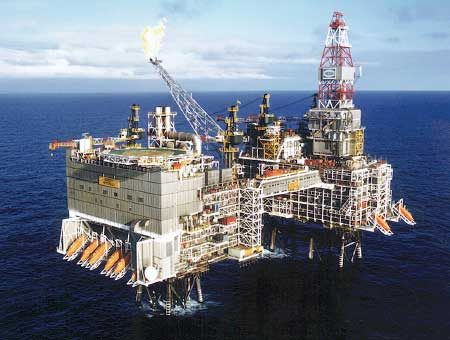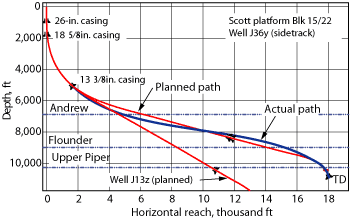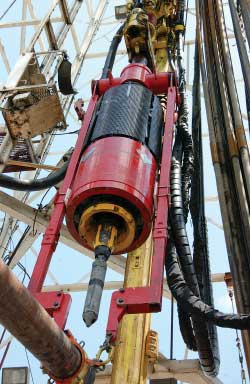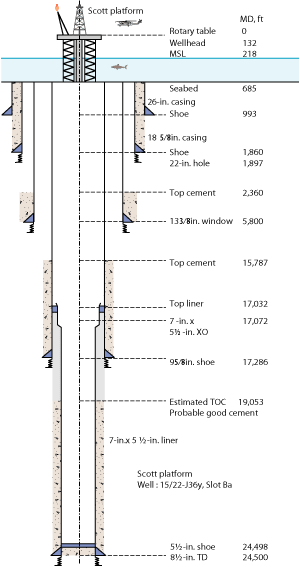An unconventional tubular running system circulates, reciprocates and rotates a casing string in a complex extended-reach well.
Bernard Warmerdam, Tracy Cummins and Craig Thomson, Weatherford International Ltd.
Late last spring, Nexen Petroleum UK Ltd. faced a drilling challenge in the J13z Marmion well, drilled on the Scott platform in the North Sea about 117 mi northeast of Aberdeen, Scotland, Fig. 1. The operator’s drilling program had placed a 13 3/8-in. casing shoe in Well J13z at a depth of 5,929 ft with an angle of 51°. However to reach total depth, the operator needed to drill the 12¼-in. section to a planned depth near 20,000 ft with a final inclination of 75°.
|

|
|
Fig. 1. The Scott platform is in the North Sea about 117 mi northeast of Aberdeen, Scotland.
|
|
Extended-reach Well J36y, a sidetrack of Well J13z, was the longest drilled well from the Scott platform to date. The initial 12¼-in. section was abandoned due to incurable losses combined with troublesome shales around the top of the Andrew formation at 6,800 ft TVD. The required increase in angle and the drilling distance for the 12¼-in. hole presented the operator with considerable challenges. Included were severe mud losses and sticky conditions caused by hole caving behind the pipe, which hindered trip-in and trip-out.
To move forward, the hole had to be drilled efficiently and safely in a way that mitigated severe drag and wellbore sloughing-conditions typically experienced when lowering a casing string into the wellbore using conventional tools. The S-shaped sidetrack well kicked off from a window in the 13 3/8-in. casing at 5,800 ft with a 75° inclination tangent section. After modifying the profile to avoid the geological weak zone and refining Extended Reach Drilling (ERD) techniques, the well’s 12¼-in. section was successfully drilled, Fig. 2.
|

|
|
Fig. 2. Well J13z cut troublesome shales near the Andrew formation top at 6,800-ft TVD, causing abandonment of the initial 12¼-in. section and drilling of sidetrack Well J36y.
|
|
Concerns remained, however, that running the 9 5/8-in. casing through the potentially weak and unstable formations at 75° inclination might be problematic. The ability to easily switch to washing down over troublesome sections and then rotate where necessary was identified as an advantage in delivering the well. In addition, because of the casing length, the string weight of 462 tons required equipment with increased hoisting capacity to pull the casing string up the hole in the event it became stuck.
An operator using conventional tools can only pull casing out of the well joint-by-joint, laying it down on the deck and going back into the well with a drill bit assembly and drill pipe to check hole conditions, ream out the hole and attempt to run casing again. This process can result in costly drilling time delays, which most operators are determined to avoid.
A number of systems were considered, including standard casing tools, to overcome the problem. Selection was based on system capabilities for getting the ERD well to TD. The OverDrive casing running and drilling system with the TorkDrive 750 heavy-duty tool was selected for use on the well’s 9 5/8-in. casing run, Fig. 3. A critical feature was the system’s ability to circulate, reciprocate or push down and rotate the casing, allowing the string to pass through numerous tight spots. On the 9 5/8-in. casing, run-critical parameters were established prior to entering the 12¼-in. openhole and these were monitored against pre-programmed trend sheets.
|

|
|
Fig. 3. A casing running and drilling system with a heavy-duty tool was selected for use on the well’s 9 5⁄8-in. casing run.
|
|
The system featured electronic torque measurement independent from the top drive, a mechanical friction-and-wear reducing roller centralizer system, a reamer shoe system for flushing away cuttings and debris, and a 750-ton advantage for increased string weight and potential over-pull requirements. This provided sufficient capacity for pulling a stuck casing string up the hole. The system has mechanized functions with fewer moving parts and requires fewer personnel, giving safety and cost advantages.
Unlike conventional lifting equipment, this system’s makeup/breakout tool was lowered over the pipe and clamped onto the joint. The driller then rotated the top drive to make up the connection. By making up the connection with the makeup/breakout tool, the torque applied could be measured independently from the top drive. The monitoring system provided a graphical display and record for each joint.
The entire string weight was lifted; the rotary spider, holding the rest of the string, was opened and the string was lowered into the well. A safety interlock system prevents simultaneous opening of the tool and the spider. The tool allowed the operator to fill the casing string with fluid, while lowering into the well, and also allowed switching to circulating mode.
Friction-reducing roller centralizers were installed on the casing string with blades designed to collapse with a predetermined side force to bypass restrictions. This allowed the casing to be safely run or pulled without losing the hole because of permanently stuck pipe. Centralizers were combined with a 12-in. OD reamer shoe on the bottom to provide a cutting structure and guide nose for rotating and reciprocating with the casing string. This was to overcome unexpected restrictions and challenging well sections at 6,800 ft and 11,000 ft.
While running through openhole, the string required washing through obstructions from 6,628 ft to 6,725 ft with 305 gpm. Running-In-Hole (RIH) continued from 6,725 ft to 7,874 ft with a persistent 40,000-lb drag. At 7,874 ft, engineers observed that there were no returns. The string was then pulled back to 7,670 ft and worked until rotation was established. The decision was then made to wash and rotate on every joint while running in. By 8,764 ft MD, 254 bbls of mud had been lost to the formation.
The string was worked from 8,764 ft to 13,730 ft; although it stalled out regularly (the limit was 18,000 ft-lb of makeup torque for the casing connection). Engineers continued RIH from 13,730 ft to 14,716 ft. Rotation was no longer possible, but the string was now beyond the most difficult hole section.
At 14,716 ft, a platform power outage stopped the job for 9.5 hr. When full power returned, the string was still free. Engineers continued RIH from 14,716 ft to 17,138 ft. The running speed improved to ±10 joints per hour with less drag, due to roller-type centralizers fitted around the 9⅝-in. casing that remained inside 13⅜-in. casing. The 9 5/8-in. casing was landed with the shoe at 17,286-ft MD. “The ability to switch to washing and rotation was integral to the success of this casing run,” said Chris Kelly, Nexen’s Scott Drilling Team lead.
The objective was reached with casing run to a final depth of 17,286 ft and the 9 5/8-in. casing was successfully cemented. Applying the tool combination enabled the drilling team to run 9 5/8-in. casing through difficult hole conditions to the intermediate TD in 94 hr, including 40 hr of circulation with rotation, reciprocation and push down.
The well was then drilled with an 8½-in. hole to a 24,500-ft TD and a 5½-in. liner was set. The well was cleaned up and completed with a monobore 5½-in. completion, Fig. 4.
|

|
|
Fig. 4. The 9 5⁄8-in. casing was run and cemented to 17,286 ft. An 8½-in. hole was then drilled to a 24,500-ft TD and a 5½-in. liner set for a monobore 5½-in. completion.
|
|
Using the system the casing was run in six days, providing significant cost savings. This was a major accomplishment for the team, since it was the first time the system was used by Nexen on a well with such an extreme angle profile. It was the second successful run for the system on a high-angle extended-reach well in the North Sea.
Operators continue to face challenges getting casing to bottom. The top drive casing running and drilling system has become a viable way to overcome some of the toughest extended-reach challenges. The tools were recently used on a 9 5/8-inch casing string for the same North Sea operator on a different well to reach a 16,000-ft TD at a 70° angle, where restrictions were encountered at 8,500 ft. The string was pulled back to 6,300 ft., the system was applied to quickly work through the trouble zones, simultaneously rotating the entire string and circulating. The tools were used below 15,600 ft, moving the drilling program toward its final TD in 105 hr.
CONCLUSION
Although Well J36y was extremely challenging, the job demonstrated that the ability to rotate and push (or pull) the casing string while circulating works for high-angle, extended-reach environments. The tools also proved effective in overcoming drag on long strings of lateral pipe, mitigated wellbore sloughing and efficiently handled other common wellbore drilling instability issues.
Many normal development drilling operations that have no major wellbore instability problems still run dedicated wiper and reamer trips to clean and prepare the wellbores for casing installation. Drilling operators can now perform hole cleaning and well preparation, while running the casing string with a reamer or drill shoe on the bottom. This application can save substantial rig time per well.
ACKNOWLEDGMENT
The authors thank the management of Nexen Petroleum and Weatherford for permission to publish this article. They also acknowledge and thank the Scott Drilling Team: Chris Kelly, Drilling and Completion Team Lead, Morris Kay, Senior Drilling Engineer and Jane Douglas, Drilling Engineer, who worked on the project, as well as all the offshore personnel involved in the drilling operation who helped deliver the well.
|
THE AUTHORS
|
|
|
Bernard Warmerdam holds an electronics degree from Europa College, as well a BA of economics degree from the Vocational University in Holland. He has worked for Weatherford for 26 years and serves as product champion for the company’s OverDrive Systems for Europe and West Africa. Warmerdam first joined Weatherford in the Netherlands as a joint-analyzed-makeup technician and was later promoted to manager of technical services prior to his present position.
|
|
| |
Tracy Cummins attended the University of Louisiana with a focus on business administration. He has been with Weatherford for 11 years and serves as the global product line champion for the company’s OverDrive Systems. Cummins has held several positions within Weatherford, including joint analyzed makeup technician, field supervisor, technical sales and project management. He has over 25 years of combined experience in tubular inspection, running and handling.
|
|
| |
Craig Thomson studied mechanical engineering at Aberdeen College. He has been with Weatherford for the last 11 years, and he serves as the mechanization and joint analyzed makeup supervisor for Weatherford. Thomson first served in several mechanical capacities within Weatherford and eventually went offshore to run casing, perform subsea cement jobs and install mechanized equipment, which led later to his supervisory role.
|
|
|







